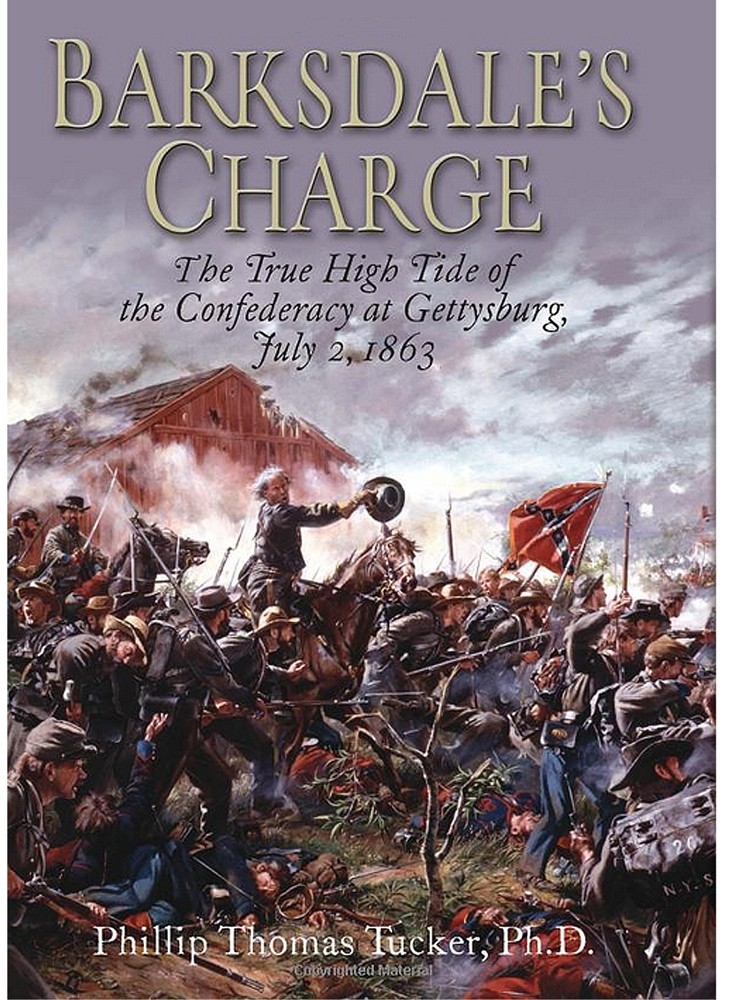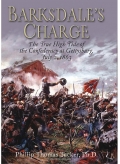site search
online catalog
BARKSDALE’S CHARGE – THE TRUE HIGH TIDE OF THE CONFEDERACY, JULY 2, 1863

$20.00 SOLD
Originally $32.95
Quantity Available: None
Item Code: ST501110
Tucker, Philip T. Savas Beattie, 2013. 6x9 hardcover, 320 pp. 29 photos, 6 maps, bibliography, index, endnotes.
From the publisher:
On the third day of Gettysburg, Robert E. Lee launched a magnificent attack. For pure pageantry it was unsurpassed, and it also marked the centerpiece of the war, both time-wise and in terms of how the conflict had turned a corner—from persistent Confederate hopes to impending Rebel despair. But Pickett’s Charge was crushed by the Union defenders that day, having never had a chance in the first place.
The Confederacy’s real “high tide” at Gettysburg had come the afternoon before, during the swirling conflagration when Longstreet’s corps first entered the battle, when the Federals just barely held on. The foremost Rebel spearhead on that second day of the battle was Barksdale’s Mississippi brigade, which launched what one (Union) observer called the "grandest charge that was ever seen by mortal man.
Barksdale’s brigade was already renowned in the Army of Northern Virginia for its stand-alone fights at Fredericksburg. On the second day of Gettysburg it was just champing at the bit to go in. The Federal left was not as vulnerable as Lee had envisioned, but had cooperated with Rebel wishes by extending its Third Corps into a salient. Hood’s crack division was launched first, seizing Devil’s Den, climbing Little Round Top, and hammering in the Wheatfield.
Then Longstreet began to launch McLaws’ division, and finally gave Barksdale the go-ahead. The Mississippians, with their white-haired commander on horseback at their head, utterly crushed the peach orchard salient and continued marauding up to Cemetery Ridge. Hancock, Meade, and other Union generals desperately struggled to find units to stem the Rebel tide. One of Barksdale’s regiments, the 21st Mississippi, veered off from the brigade in the chaos, rampaging across the field, overrunning Union battery after battery. The collapsing Federals had to gather men from four different corps to try to stem the onslaught.
Barksdale himself was killed at the apex of his advance. Darkness, as well as Confederate exhaustion, finally ended the day’s fight as the shaken, depleted Federal units on their heights took stock. They had barely held on against the full ferocity of the Rebels, on a day that decided the fate of the nation. Barksdale’s Charge describes the exact moment when the Confederacy reached its zenith, and the soldiers of the Northern states just barely succeeded in retaining their perfect Union.
Inquire About BARKSDALE’S CHARGE – THE TRUE HIGH TIDE OF THE CONFEDERACY, JULY 2, 1863
For inquiries, please email us at [email protected]
Most Popular
Historical Firearms Stolen From The National Civil War Museum In Harrisburg, Pa »
Theft From Gravesite Of Gen. John Reynolds »
Cavalry Carbine Sling Swivel »
Fine Condition Brass Infantry Bugle Insignia »
featured item
CAPTAIN W.W. RANDOLPH: LIKELY WILLIAM WELFORD RANDOLPH, 2nd VIRGINIA, LATER LT. COLONEL, KIA THE WILDERNESS 1864
Identified as Capt. W.W. Randolf (sic) in the files of the late Bill Turner, noted Virginia collector and dealer, this six plate ambrotype shows Randolph seated with one hand on his thigh and the other resting on a book atop a photographer’s table… (1138-1803). Learn More »



